How one Singapore architect made this narrow, inter-terrace house feel spacious
By carefully planning the layout of the staircases in this three-storey (plus attic) terrace house, architect Edmund Ng gave more room for individual spaces to breathe.

The living and dining areas are seamless and stretch the entire house's length. (Photo: Edwin Tan Studio)
If you were invited for a meal to this house, you would be surprised looking up from the dining table to see the underside of a staircase. It is the main organising and aesthetic element that architect Edmund Ng has inserted into the double-volume atrium of this inter-terrace dwelling, setting it apart from other such housing types.
A couple with three grown children live in this 312sqm home. They had purchased the plot, as their previous three-storey apartment did not provide the space they desired. This house was the first they had viewed and they were drawn back to it after looking at several more.
READ> House tour: A Singapore family home with its own indoor trampoline
The staircase in question is made of black-painted steel. It has a thin profile but a bold presence, sculpting from the second storey up towards the third, and then the attic. From the dining table, you can witness its twisting underbelly of articulated treads and risers, and a sliver in the centre that lets light tunnel downward from a skylight at the house’s apex.
Helmed in between a white-painted wall, a fair-faced concrete wall and a luxurious abundance of empty space, the staircase is captivating. During the day, the blackness becomes a canvas for white strips of natural light shaped by the skylight’s trellis.
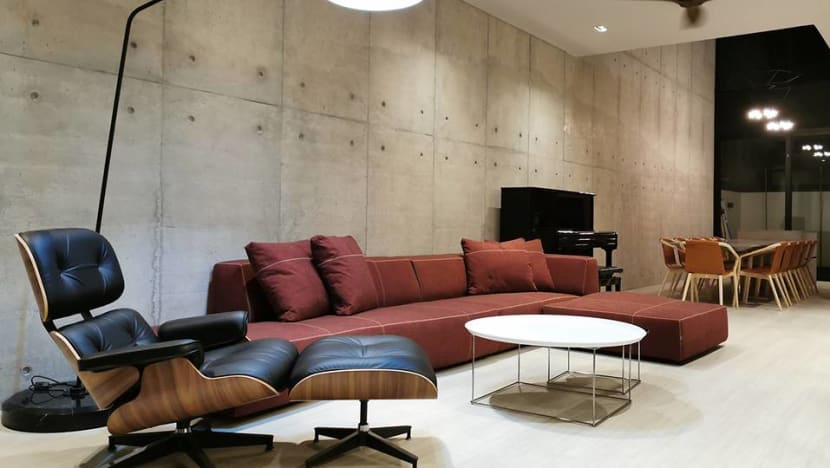
The original house on the plot also had a staircase rising up its centre, but it was nothing like this lively fixture. Like the other houses in the row, a ubiquitous dogleg staircase and a toilet segmented the first storey’s front and rear. This was one of the main reasons why Ng, who runs his eponymous practice, convinced the owners that it was more logical to demolish and rebuild the house rather than simply renovate it.
The original house also had many split-levels that would be inconvenient for the owners, who were planning to live here in their aging years. The new plan saw a straight flight of steps from the first storey to the second, abutting the parti-wall. Ng positioned serviced spaces, such as the bomb shelter, lift core and bathrooms, along this perimeter.

“One of the inter-terrace’s disadvantages is the narrow width. If we had continued the straight-flight staircase [up to the top storey], that would leave us little space on the first storey,” said Ng. It would also have limited the size of the bedrooms upfront, which would have been eaten into by a conventional dogleg staircase.
The spiral staircase that services the second storey onwards was a unique solution. Floating it above the loft dining area freed up space on the first storey for Ng to create a seamless living and dining area that stretches across the house’s entire length. It is a great environment for entertaining friends, which the couple like to do.
“One of the inter-terrace’s disadvantages is the narrow width. If we had continued the straight-flight staircase [up to the top storey], that would leave us little space on the first storey.” – Edmund Ng
READ> Can a small apartment be made to feel larger and more luxurious?
A sinuous burgundy B&B Bend sofa snakes across the living room, facing a wall of shelving and storage that displays mementos, and the family’s beloved collection of Iladro porcelain sculptures. These linear elements lead the eye toward a long, custom-designed dining table that joins to a stainless steel and marble dry kitchen counter such that food preparation, consumption and social interaction is an uninterrupted, layered affair.
Beneath the table, Ng incorporated many sockets to facilitate today’s technologically-driven lifestyle, while on one wall, light timber-veneered cabinetry conceals clutter and balances the opposing concrete wall’s raw, stoic personality.

The dwelling’s moniker, Double Volume House, references another key feature – the lofty space where the dining room sits. Visiting the plot, Ng had noticed that the rear windows faced a condominium estate which had towers that were positioned at a distance. This presented the opportunity to create double-height windows that would flush the space with light and views of blue skies and shifting clouds.
The gesture changed the character of the inter-terrace house. It is at once open and uplifting instead of pokey. The windows also borrow the foliaged scenery of the matured trees in the neighbouring estate. At night, when all is dark outside, this wall of glass presents itself as a large, black panel that dialogues spatially with the black spiral staircase in the atrium.
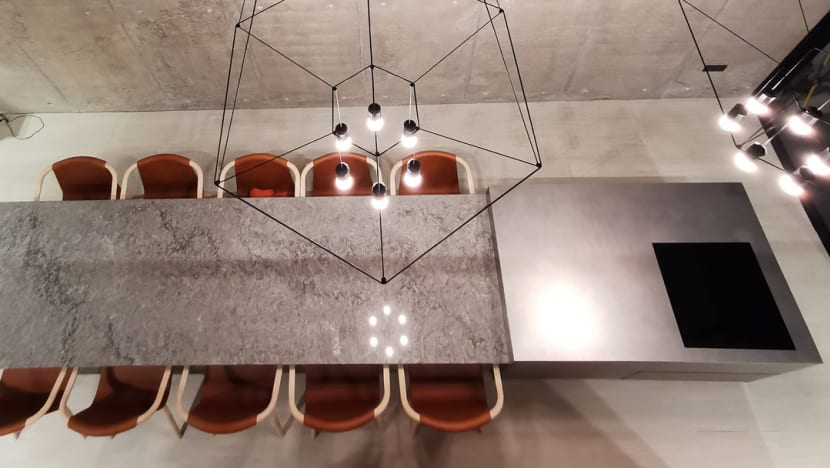
“One of the differences between apartment and house living is the ability to enhance the spaces [with features such as] this double-volume space,” said Ng. The spiral staircase helps to emphasise its verticality, as do the twin Vibia Wireflow chandeliers that were chosen for their barely-there profiles.
The thin cables cast geometric shadows onto the fair-faced concrete wall, injecting a decorative aspect without overwhelming the space. At first, the owner was not used to such lighting fixtures, being more used to traditional chandeliers. “It was a leap of faith. I thought it looked too skeletal, but now I love it,” he said.
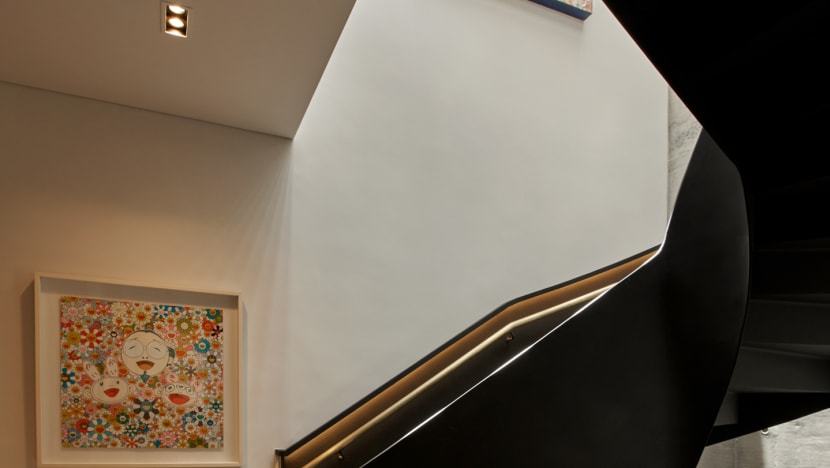
READ> A home away from home? A new Batam integrated township has launched
This was one of the many decisions he trusted Ng with, which resulted in a dwelling that is both pragmatic for his family’s daily use as well as enlivening. On making sure the house was elderly friendly, some decisions included making the first storey staircase wider than normal, with sturdy brass grip handrails and steel staircase treads that curve at the edge.
It leads to the second storey where the master bedroom is located. “The linear flight is easier for the owners to go to the master bedroom, especially in their latter years, but the spiral staircase is fine for the kids,” Ng commented. He also placed the maid’s room and bathroom on the same level, elevating her position in the household.
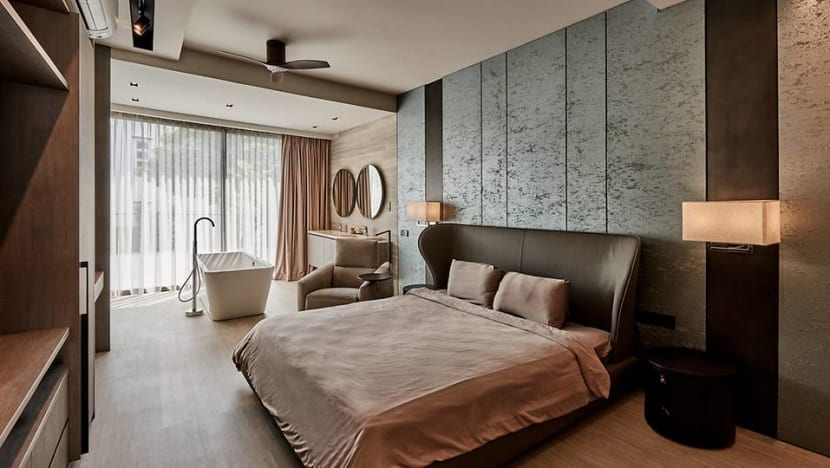
“It is very hospitality-driven,” said Ng on the trick borrowed from boutique hotels that celebrate the cleansing process as a ritual of relaxation – and sometimes, exhibitionism – rather than utilitarianism. Functionally, it also allows the bathrooms to have natural ventilation and light from the window. The owner shared that he enjoys soaking in the tub almost daily.
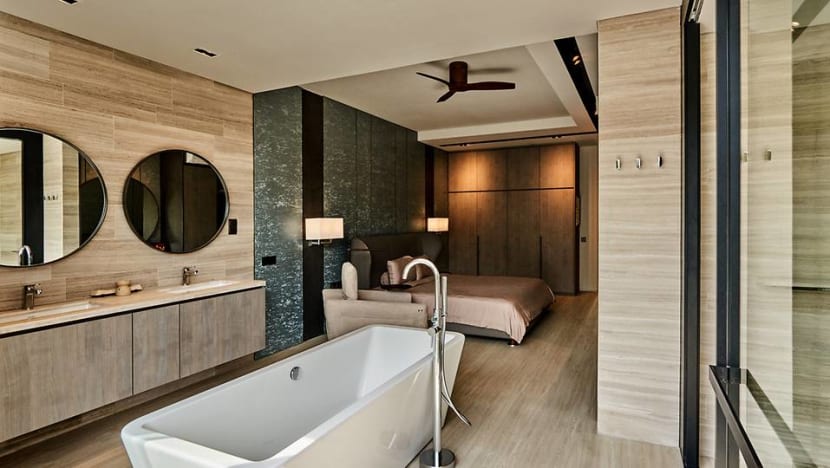
While the walls in the other parts of the house are whitewashed or concrete, here, the owner’s wife indulges in her love for wallpaper. The fair-faced concrete was more her husband’s preference. The textured walls are matched with light timber vinyl flooring and curtains in an earthy shade.
On the third storey, there are bedrooms for two of the children and their grandmother, who visits regularly. At the attic level is a private space for the middle son, which comes with a balcony that sends breezes down the interiors when the doors are open.

The owner had originally wanted a full glass facade but Ng convinced him to incorporate aluminium screens for privacy and shade. Together with concrete and granite walls, the horizontal members project a neat appearance that is entirely contemporary compared to the neighbours’ terracotta tiled roofs, and quaint frontages accented with curved balconies and windows.
This conservative front belies the multitude of innovative manoeuvres by Ng that turned a cloistered, ubiquitous and narrow home into one that is artful, voluminous and enjoys abundant light, air and space.












